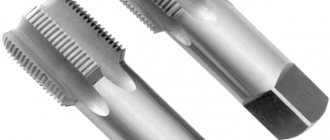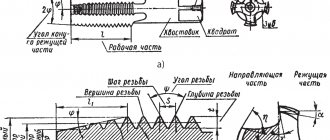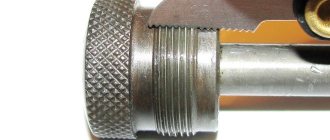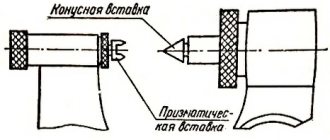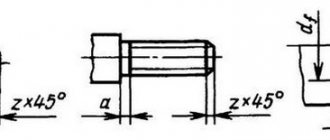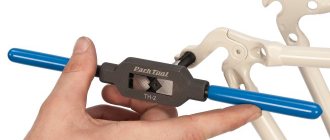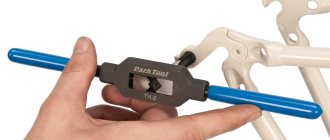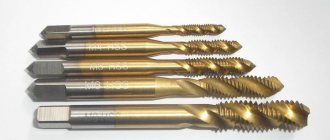The popularity of threaded connections is explained by the ease of implementation and the strength of fastening the structural elements to each other. When the threads are damaged and replacement of the part is impossible, the threads are restored. Since threads can be restored in different ways, choose the one that maintains the strength of the connection at the same level.
Cold welding restoration technology
To restore threads by cold welding, polymer compounds with metal additives are produced. The restoration procedure with liquid two-component glue is performed in the following sequence:
- take two tubes out of the package;
- the connection parts are degreased with the substance from tube No. 1;
- then apply the contents of tube No. 2;
- use a spatula to mix the compositions from both tubes in a 1:1 ratio;
- the finished mixture is applied to the bolt from the external thread side;
- then screwed into the internal threads;
- after the mixture has hardened (the holding time is indicated in the instructions), the bolt is turned out.
To ensure high-quality restoration of the turns, the mixture is applied in excess so that the excess is squeezed out when screwing in the bolt.
It is better to choose a cold welding composition with high ductility
Which cold welding to choose
Due to its low efficiency, a one-component anaerobic reducing agent in the form of a thick paste is rarely used. For repair work, two types are used:
- liquid composition, which is obtained after mixing the hardener with the adhesive mass;
- dense single-layer or two-layer bars with a consistency similar to plasticine, which are mixed before use.
To restore damaged turns, grades with high ductility are selected so that the mixture fills small flaws. If the connection is often disassembled, cold welding with increased hardness is needed, otherwise the composition will be destroyed by friction with the metal.
Advantages and disadvantages
The advantages of the cold welding method include:
- the possibility of a wide choice in price and quality among domestic and foreign manufacturers;
- restoration without dismantling the structure;
- corrosion resistance;
- simplicity, since restoration is performed without auxiliary devices;
- unchanged characteristics of parts due to the absence of thermal effects;
- low price.
Tapping threads
This method is used when the hole size can be increased without compromising the reliability of the connection. Using a drill, increase the diameter to clear the hole of damaged turns, then cut new ones.
The work is performed according to the following rules:
- the hole is drilled strictly perpendicularly;
- use two taps for cutting threads, rough and finishing;
- to remove chips, after 3 direct revolutions, make 1.5 reverse ones;
- To facilitate the process, the tool is lubricated with oil.
How to restore a thread with a tap
Before restoring a thread with a tap, determine whether it is possible to increase its diameter or cut a new one in a different location. If yes, then the repair will take place very quickly.
- Drill out the hole.
- Cut new thread.
Photo No. 1: tapping threads
When working, observe the following basic rules.
- Drill the hole strictly at a right angle
- Use two new taps of the required diameter (for roughing and finishing).
- Be careful when cutting threads. Avoid distortions and sudden movements.
- It is advisable to cut the thread using a wrench. If you don't have one, take an adjustable wrench.
- Remember to use lubricant and remove chips regularly.
Application of spiral insert
Such devices, also called wire or spring, are made of high quality stainless steel. The inserts are made in the form of cylindrical spirals with concentric threads inside and outside. A leash is provided for installation. The shape and size of the internal turns are made with minimal tolerances.
Thread repair kit with spiral insert
Thread repair is performed in the following sequence:
- the hole is drilled with a drill, the diameter of which is selected according to the table attached to the inserts;
- the turns are cut using non-standard taps included in the kit;
- the insert is screwed in with the tool included in the kit;
- remove the leash with the tool supplied by the manufacturer, or with pliers if the diameter is large.
Due to the tension during installation, spontaneous unscrewing of the insert is prevented. The elasticity of the material ensures uniform load distribution between the bolt and the insert. The high corrosion resistance of stainless steel eliminates the possibility of the bolt jamming due to rust.
Spiral inserts can be used to repair connections on structures made of non-ferrous or ferrous metal. They are also used to reinforce carvings on plastic and wood.
How to restore threads in a hole without a tap
The question of how to restore the thread in a hole without a tap is often asked by people who do not understand threaded connections at all. There is only one answer to this question. It is impossible to restore the thread to obtain maximum reliability without using conventional or special taps. There are only ways to build up damaged surfaces and strengthen the strength of joints to certain levels.
Using Epoxy Glue
This method is not suitable for restoring and strengthening connections subject to high loads and vibrations. There is also no point in using epoxy glue if components and structures operate at high temperatures.
Photo No. 4: epoxy glue for thread restoration
If there is no need to ensure high connection reliability, proceed this way.
- Fill the hole with epoxy glue.
- Wait until the polymer hardens.
- Screw in the bolt.
- Wait for the depravity to set.
Screwdriver for thread restoration
Screws, also known as futorki, are made in the form of hollow bushings with large external and small internal threads. They can be steel, copper, brass, bronze, or other materials. Fittings are installed on parts where an increase in the diameter of the holes is allowed. Screwdrivers are used in many industries, for example, for assembling furniture, joining pipes, and fastening dual wheels.
Thread repair kit with thread insert
Some manufacturers produce kits called thread restorers. The kits consist of inserts of different sizes, drills, taps, and auxiliary tools. Depending on the purpose, the kits include fittings for repairing inch or metric threads from M2 to M36.
Traditional welding for repairs
This technology is used if it is impossible to increase the diameter of the hole, and when the required screw or spiral insert is not available. The recovery procedure is performed in the following order:
- drill out damaged coils;
- weld the hole;
- the deposited area is cleaned flush with the surface;
- drill a hole;
- cut the thread.
Gas or electric arc welding in protective environments is used to restore steel connections. Holes in cast iron are welded cold or with local heating. Electrodes of the TsCh-4, OZCh-1, MNCh-1 brands or cast iron rods with the addition of silicon are melted as filler material. It should be taken into account that under the influence of high temperature the structure of the metal of the part changes, and cracks may form. Therefore, the strength of the repaired connection will be less.
Holes in aluminum parts, which a car engine cannot do without, are welded using argon-arc welding. Aluminum wire is used for surfacing. However, when restoring threads in aluminum, the liquid metal begins to actively absorb gases. Pores form, and when shrinking during cooling, cracks form, which reduce the reliability of the connection. It is not always possible to restore using this method without removing parts. For example, to repair connections on an aluminum cylinder block, the structure will have to be dismantled.
When choosing a restoration method, operating conditions and load magnitude are taken into account. The complexity of implementation and price are also taken into account. For example, purchasing a spiral insert is cheaper than ordering a screw-in insert.
How to restore a thread with a tap while maintaining its diameter and location
If you need to restore the thread while maintaining its diameter, use one of the following methods.
Welding the hole and then cutting a new thread
This method is rarely used due to the fact that the strength of the new thread obtained using this technology will be lower. This method is also chosen in the absence of special devices (screws and spiral inserts).
This method of thread restoration includes the following steps.
- Removing old threads by drilling.
- Welding the hole. The choice of technologies depends on the materials of the parts.
To weld holes in steel products, electric arc or gas welding is used in protective environments.
- When working with cast iron parts, gas or electric arc welding is used in a cold state or with general/local heating.
- Electrodes (MNCh-1, OZCh-1, TsCh-1), cast iron rods with a high silicon content and other materials are used as additives.
Note! When working with aluminum products, this method of thread restoration is usually not used. This is due to the fact that the metal actively absorbs gases during welding. Pores form in the deposited layers. With severe shrinkage, cracks appear.
Restoring threads using a screwdriver
Screwdrivers are special cylindrical devices that have threads of the required diameter and pitch on the inside and large threads on the outside. Such products are made from steel, brass, bronze, copper and other materials. At the final stages of production, the screws are hardened and further strengthened.
Photo No. 2: screwdriver for thread restoration
If you need to restore the thread while maintaining the diameter using a screwdriver, proceed as follows.
- Drill out the hole. The drill must be selected in such a way that the diameter of the resulting hole allows cutting a thread for screwing in the screw.
- Cut the thread with a tap. Follow the rules listed above.
- Screw in the screwdriver. It needs to be installed flush. If this is not possible, mill the part and remove the protruding part of the fixture.
- At the border of the new thread and the screw, apply notches using a core. This will prevent the device from unscrewing spontaneously.
Repairing threads using a spiral insert
Spiral (also called wire and spring) inserts are also often used to restore damaged threads.
Photo No. 3: spiral inserts for thread restoration
These devices have high-precision rhombic threaded profiles on the inside. Almost all models are equipped with special driving tongues designed for screwing in devices.
For the manufacture of such products, especially durable high-quality stainless steel is used. This guarantees the resistance of the restored thread to deformation and corrosion.
Restoring threads using a spiral insert includes 4 stages.
- Drilling. Drill out the hole. Select the diameter of the cutting tool according to the table that manufacturers provide with spiral inserts.
- Thread formation. Note! To cut threads, use special taps that differ from standard ones and come with spiral inserts. Follow all rules and recommendations.
- Installation of the device. Place the spiral insert onto the supplied special tool and screw it into the hole.
- Removing the drive tongue. You can get rid of it using a special tool (manufacturers also supply it). To remove tabs from large-diameter inserts, ordinary pliers are suitable.
Image #1: Drilling the hole for the spiral insert
Image #2: Forming a thread for a spiral insert
Image #3: screwing the spiral insert into the hole
Using professional spiral thread inserts has the following advantages.
- The required tension is ensured at the insert landing site. This completely prevents twisting. The devices are located in the receiving threads with virtually no gaps. There is no need to use glue for additional fixation of products.
- Due to the elasticity of the inserts, loads and stresses are distributed evenly. This creates ideal conditions for the transfer of forces between the bolts and the receiving threads.
- Spiral inserts are universal. They are used not only to restore threads, but also when it is necessary to strengthen connections. Spiral inserts are used when working with products made of low-medium and high-strength metals, as well as plastic and wood.
